
SEBASTIAN — Dr. Brian LaPointe, a research professor at Florida Atlantic University and a top water quality expert, told a packed Sebastian Lagoon Workshop Wednesday night that the greatest source of the pollution that has plunged the 156 miles of Indian River Lagoon into crisis is likely caused by septic tanks.
The Sebastian City Council has discussed and debated the lagoon issue, seeking causes of the pollution that affects, specifically, the Sebastian/Treasure Coast section of the lagoon, which is impacted from different outflow sources than areas farther to the south.
Human development, said Lapointe, is the common thread in the pollution of coastal waters nationally, even globally. He explained that the nutrients in wastewater, principally nitrogen and potassium, feed the algae which in turn bloom explosively, diminish light and oxygen, and kill the seagrass, a vital foodsource for lagoon inhabitants.
With an estimated 1.7 million septic tanks potentially impacting the entire lagoon, LaPointe said that a full 50 percent of the watershed flow is septic-tank-treated and, further, that his studies show that, with the low elevation, low organic matter and sandy soil, even with septic tank treatment, a very high percentage of nitrogen still enters the watershed.
“People say their septic tank is working fine because it hasn’t backed up, but that is not the bar we use,” he said.
Although LaPointe’s presentation was lengthy and often technical, his explanations were concise and to the point, and the audience listened intently throughout.
Among those present were County Commission Chairman Peter O’Bryan and Arjuna Weragoda, Capital Projects Manager with the County Utilities Department. Weragoda said the county was planning a sewerage project for the Sebastian area and would provide the Sebastian Council with a copy of the project document as soon as it was approved by the County Commission.
Apparently, it was the first the Sebastian Council had heard of it, and Council member Andrea Coy diplomatically but firmly stated that Sebastian would very much like to be part of the project and to be informed about it henceforth, since it was, in fact, a Sebastian project.
Coy then reminded O’Bryan and Weragoda that Sebastian had put aside money – $100,000 – as part of a Sebastian sewer project that was supposed to be done jointly, but never was.
Interim City Manager Joe Griffin confirmed that it had “come to an abrupt halt” when the county wanted to do a study.
When Weragoda said there were concerns the line would be put in and no one would want to hook up, Coy responded that there were people already signed up to hook in.
“Let’s get it going,” she urged. “We’ll get the people to connect, That’s our job. We’re ready to go!”
LaPointe told the audience that Rep. Patrick Murphy and his delegation were looking at lagoon-wide federal funding for sewer infrastructure this session, possibly in the millions, and urged everyone to contact Gov. Rick Scott to bring back the designated $20 milllion for the lagoon he had vetoed in the last session.
Following the presentation and the public comments, Council agreed to have Griffin draft a letter to Gov. Scott urging the reinstatement of the lagoon funding.
“We’ve had years of study!” Coy said. “We’re on lagoon conference overload. Data! Data! Data! Data! Let’s get off our butts, and get more aggressive.”



